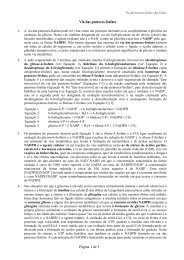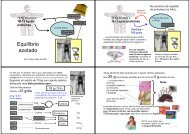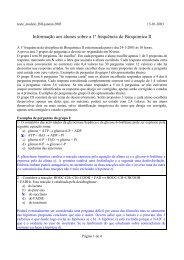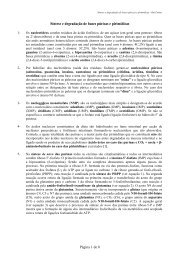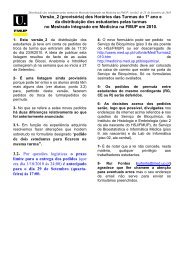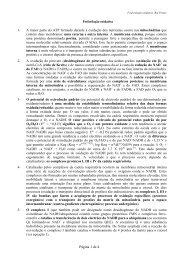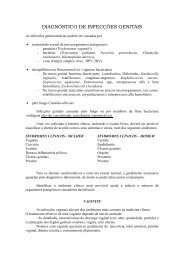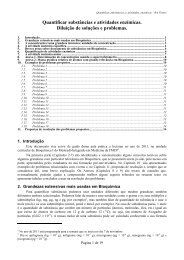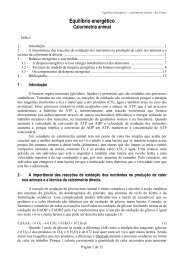the importance of system integration in intensive care units
the importance of system integration in intensive care units
the importance of system integration in intensive care units
You also want an ePaper? Increase the reach of your titles
YUMPU automatically turns print PDFs into web optimized ePapers that Google loves.
THE IMPORTANCE OF SYSTEM INTEGRATION<br />
IN INTENSIVE CARE UNITS<br />
A Review<br />
Rui Fonseca 1,2 and Pedro Pereira Rodrigues 1,3<br />
1<br />
Faculty <strong>of</strong> Medic<strong>in</strong>e, University <strong>of</strong> Porto, Al. Pr<strong>of</strong>. Hernâni Monteiro, 4200-319 Porto, Portugal<br />
2 Faculty <strong>of</strong> Sciences, University <strong>of</strong> Porto, Rua do Campo Alegre, s/n, 4169-007 Porto, Portugal<br />
3 LIAAD - INESC Porto, L.A. & CINTESIS - Center for Research <strong>in</strong> Health<br />
Technologies and Information Systems, Porto, Portugal<br />
rn.fonseca@gmail.com, pprodrigues@med.up.pt<br />
Keywords:<br />
Abstract:<br />
Intensive Care Units, System <strong><strong>in</strong>tegration</strong>, Electronic Health Records, Patient outcome.<br />
Due to <strong>the</strong> severity <strong>of</strong> patients treated <strong>in</strong> <strong>the</strong> <strong>in</strong>tensive <strong>care</strong> <strong>units</strong>, <strong>the</strong>se <strong>units</strong> are commonly equipped with a<br />
variety <strong>of</strong> equipment that is handled by a multidiscipl<strong>in</strong>ary team. In order to identify problems, present and<br />
future, cl<strong>in</strong>icians perform periodic assessments that produce huge amount <strong>of</strong> data, which availability is <strong>of</strong><br />
vital <strong>importance</strong>. This study was performed <strong>in</strong> order to assess <strong>the</strong> impact <strong>of</strong> cl<strong>in</strong>ical data centralized <strong>in</strong> a<br />
cl<strong>in</strong>ical <strong>in</strong>formation <strong>system</strong> for <strong>in</strong>patients <strong>in</strong> an <strong>in</strong>tensive <strong>care</strong> unit, when compared with data dissem<strong>in</strong>ated<br />
<strong>in</strong> different <strong>system</strong>s. A literature search was conducted on PubMed <strong>in</strong> order to identify relevant articles<br />
published between 2000 and 2010. From a total <strong>of</strong> 48 articles, 7 articles were selected for assessment. 2<br />
articles studied <strong>the</strong> impact <strong>of</strong> <strong>system</strong> <strong><strong>in</strong>tegration</strong>, 4 articles studied <strong>the</strong> impact <strong>of</strong> computerized medical<br />
records and 1 article studied both <strong>the</strong> impact <strong>of</strong> computerized medical records and <strong>system</strong> <strong><strong>in</strong>tegration</strong>. A<br />
centralized cl<strong>in</strong>ical <strong>in</strong>formation <strong>system</strong> was proved to have a positive impact for <strong>in</strong>patients <strong>in</strong> an <strong>in</strong>tensive<br />
<strong>care</strong> unit. These <strong>system</strong>s allow time sav<strong>in</strong>gs on vital signs transcription, reduced medication errors, a<br />
quicker access to cl<strong>in</strong>ical data and a reduction <strong>in</strong> prescription errors.<br />
1 INTRODUCTION<br />
The Intensive Care Units (ICU) are a specialized<br />
section <strong>of</strong> an hospital conta<strong>in</strong><strong>in</strong>g <strong>the</strong> equipment,<br />
medical and nurs<strong>in</strong>g staff, monitor<strong>in</strong>g and lifesupport<br />
devices necessary to provide cont<strong>in</strong>uous<br />
<strong>care</strong> to patients that are severely ill and medically<br />
unstable.<br />
Due to <strong>the</strong> severity <strong>of</strong> <strong>the</strong> patients, <strong>the</strong>se <strong>units</strong> are<br />
commonly equipped with mechanical ventilators to<br />
assist breath<strong>in</strong>g, cardiac monitors <strong>in</strong>clud<strong>in</strong>g<br />
telemetry, external pacemakers and defibrillators,<br />
dialysis equipment for renal problems, equipment<br />
for <strong>the</strong> constant monitor<strong>in</strong>g <strong>of</strong> bodily functions, a<br />
web <strong>of</strong> <strong>in</strong>travenous l<strong>in</strong>es, feed<strong>in</strong>g tubes, nasogastric<br />
tubes, suction pumps, dra<strong>in</strong>s and ca<strong>the</strong>ters, and a<br />
wide array <strong>of</strong> drugs to treat <strong>the</strong> ma<strong>in</strong> conditions. All<br />
<strong>of</strong> this equipment is handled by a multidiscipl<strong>in</strong>ary<br />
team that may be consisted, among o<strong>the</strong>rs, by<br />
<strong>in</strong>tensivists (cl<strong>in</strong>icians who are specialized <strong>in</strong> critical<br />
illness <strong>care</strong>), cl<strong>in</strong>ical pharmacists, nutritionists,<br />
nurses, anaes<strong>the</strong>siologists, surgeons or emergency<br />
medic<strong>in</strong>e specialists.<br />
In order to identify problems that may arise and<br />
require urgent attention or treatment, cl<strong>in</strong>icians<br />
perform periodic assessments <strong>of</strong> <strong>the</strong> patient's cardiac<br />
status, breath<strong>in</strong>g rate, ur<strong>in</strong>ary output, and blood<br />
levels. In some cases, patients may need special<br />
requirements for monitor<strong>in</strong>g. That’s <strong>the</strong> case for<br />
patients who are admitted to <strong>the</strong> ICU for observation<br />
after surgery. These patients may have ca<strong>the</strong>ters<br />
placed to detect hemodynamic changes (blood<br />
pressure changes) or require endotracheal <strong>in</strong>tubation<br />
to help <strong>the</strong>m breath, with <strong>the</strong> breath<strong>in</strong>g tube<br />
connected to a mechanical ventilator. In order to<br />
perform a correct treatment, <strong>the</strong> availability <strong>of</strong><br />
detailed <strong>in</strong>formation is <strong>of</strong> vital <strong>importance</strong>.<br />
Physicians have not only to analyze data displayed<br />
by <strong>the</strong> equipment, but also to analyze laboratory and<br />
radiology results, evaluate patient’s history and<br />
current medication, analyze patient-specific<br />
<strong>in</strong>formation such as age, weight and height, analyze<br />
142
THE IMPORTANCE OF SYSTEM INTEGRATION IN INTENSIVE CARE UNITS - A Review<br />
warn<strong>in</strong>gs <strong>of</strong> drug <strong>in</strong>teractions and evaluate<br />
diagnoses.<br />
All <strong>the</strong> mentioned <strong>in</strong>formation is extremely<br />
important to physicians <strong>in</strong> order to prevent mistakes,<br />
to decide <strong>the</strong> better treatment plan and to perform<br />
acts that allow a better patient outcome. However, <strong>in</strong><br />
some cases, <strong>the</strong> <strong>in</strong>formation is distributed by various<br />
<strong>in</strong>formation <strong>system</strong>s, which may result <strong>in</strong> a huge<br />
time loss when look<strong>in</strong>g for specific data.<br />
The aim <strong>of</strong> this study is to provide an assessment<br />
<strong>of</strong> <strong>the</strong> impact <strong>of</strong> data centralized <strong>in</strong> one Cl<strong>in</strong>ical<br />
Information System (CIS) for <strong>in</strong>patients <strong>in</strong> an ICU,<br />
when compared with data distributed <strong>in</strong> different<br />
<strong>system</strong>s. In order to do so, <strong>the</strong> follow<strong>in</strong>g question<br />
should be answered at <strong>the</strong> end <strong>of</strong> this study:<br />
• Is <strong>system</strong> <strong><strong>in</strong>tegration</strong> important <strong>in</strong> patient<br />
outcome <strong>in</strong> <strong>the</strong> ICU, when compared with <strong>the</strong><br />
evaluation <strong>of</strong> data from different <strong>system</strong>s?<br />
• Can computerized medical records <strong>in</strong> ICU<br />
allow a better decision mak<strong>in</strong>g?<br />
• Can <strong>system</strong> <strong><strong>in</strong>tegration</strong> decrease <strong>the</strong> length <strong>of</strong><br />
stay <strong>in</strong> ICU?<br />
In order to answer <strong>the</strong>se questions, a review will<br />
be performed on <strong>the</strong> <strong>importance</strong> <strong>of</strong> <strong>in</strong>tegrat<strong>in</strong>g<br />
cl<strong>in</strong>ical data provided from equipments, laboratory<br />
and radiology results, adm<strong>in</strong>istrative <strong>in</strong>puts and<br />
cl<strong>in</strong>ician’s assessments <strong>in</strong>to one centralized <strong>system</strong>.<br />
This review will be carried out <strong>in</strong> order to identify<br />
<strong>the</strong> results <strong>of</strong> length <strong>of</strong> stay, mortality rate and<br />
patient outcome and <strong>the</strong> ability <strong>of</strong> a better decision<br />
mak<strong>in</strong>g, which should result <strong>in</strong> a better overall<br />
treatment.<br />
related to <strong>system</strong> or data <strong><strong>in</strong>tegration</strong>, (3) evaluated<br />
<strong>the</strong> patient outcome, (4) were published <strong>in</strong> English<br />
or Portuguese and (5) where available <strong>in</strong> Full text.<br />
In order to identify <strong>the</strong> articles used <strong>in</strong> <strong>the</strong><br />
review, <strong>the</strong> follow<strong>in</strong>g selection method was used, as<br />
identified <strong>in</strong> figure 2. After perform<strong>in</strong>g <strong>the</strong> search on<br />
PubMed database, <strong>the</strong> availability <strong>of</strong> full text was<br />
analyzed, result<strong>in</strong>g <strong>in</strong> <strong>the</strong> exclusion <strong>of</strong> <strong>the</strong> articles<br />
that weren’t available. At this po<strong>in</strong>t, a screen<strong>in</strong>g <strong>of</strong><br />
<strong>the</strong> title and abstract was performed, result<strong>in</strong>g <strong>in</strong> <strong>the</strong><br />
exclusion <strong>of</strong> articles by lack <strong>of</strong> <strong>the</strong> correct content.<br />
F<strong>in</strong>ally, <strong>the</strong> digital document correspond<strong>in</strong>g to <strong>the</strong><br />
article was searched and <strong>the</strong> articles that couldn’t be<br />
found were excluded. After <strong>the</strong> identification <strong>of</strong> <strong>the</strong><br />
articles <strong>in</strong>cluded for revision, its quality was<br />
analyzed through <strong>the</strong> process <strong>of</strong> read<strong>in</strong>g and<br />
selection.<br />
Figure 1: Keywords used <strong>in</strong> <strong>the</strong> search strategy.<br />
2 METHODS<br />
A literature search was conducted by one reviewer<br />
<strong>in</strong> January 2010 on PubMed <strong>in</strong> order to identify<br />
articles published between January 2000 and<br />
January 2010. The search was performed based on<br />
Medical Subject Head<strong>in</strong>g (MeSH) terms, <strong>in</strong> order to<br />
identify <strong>the</strong> <strong>importance</strong> that <strong>system</strong> <strong><strong>in</strong>tegration</strong> or<br />
computerized medical records have on ICU,<br />
<strong>in</strong>fluenc<strong>in</strong>g patient outcome results.<br />
The keywords that were used <strong>in</strong>cluded ICU <strong>in</strong><br />
conjunction with System <strong><strong>in</strong>tegration</strong> or<br />
Computerized medical records. These terms were<br />
<strong>the</strong>n used <strong>in</strong> conjunction with Decision support<br />
<strong>system</strong> or Decision mak<strong>in</strong>g or Outcome and process<br />
assessment or Hospital mortality or Length <strong>of</strong> stay<br />
as it can be seen <strong>in</strong> figure 1.<br />
The <strong>in</strong>clusion criteria required that <strong>the</strong> studies:<br />
(1) where based on <strong>in</strong>tensive <strong>care</strong> <strong>units</strong>, (2) were<br />
Figure 2: Data search, analysis and selection process.<br />
3 RESULTS<br />
As shown <strong>in</strong> figure 2, a total <strong>of</strong> 48 articles were<br />
found <strong>in</strong> scientific literature (2000-2010) that<br />
143
HEALTHINF 2011 - International Conference on Health Informatics<br />
exam<strong>in</strong>ed <strong>the</strong> outcomes <strong>of</strong> decision mak<strong>in</strong>g, decision<br />
support <strong>system</strong> and patient outcome with <strong>the</strong> use <strong>of</strong><br />
<strong>system</strong> <strong><strong>in</strong>tegration</strong> and cl<strong>in</strong>ical <strong>in</strong>formation <strong>system</strong>s.<br />
However, <strong>the</strong> analyses and selection process<br />
outl<strong>in</strong>ed <strong>in</strong> figure 2 guided to an evaluation <strong>of</strong> <strong>the</strong><br />
availability <strong>of</strong> full text articles, which lead to an<br />
exclusion <strong>of</strong> 5 articles. The 43 rema<strong>in</strong><strong>in</strong>g articles<br />
were considered for title/abstract review and a<br />
detailed screen<strong>in</strong>g <strong>of</strong> titles and abstracts resulted <strong>in</strong> a<br />
selection <strong>of</strong> 10 articles which were considered for<br />
full text review. After <strong>the</strong> identification <strong>of</strong> <strong>the</strong>se<br />
articles, 3 <strong>of</strong> <strong>the</strong>m could not be located for review,<br />
even though its title and abstract suggested that <strong>the</strong>y<br />
would have been selected for <strong>in</strong>clusion. Perform<strong>in</strong>g<br />
this process led to an <strong>in</strong>clusion <strong>of</strong> 7 articles. One <strong>of</strong><br />
<strong>the</strong>se articles is a narrative review that focuses on<br />
<strong>the</strong> benefit <strong>of</strong> us<strong>in</strong>g Computerized Physician Order<br />
Entry (CPOE) <strong>in</strong> perform<strong>in</strong>g a better patient<br />
outcome (Rothschild, 2004).<br />
As shown <strong>in</strong> table 1, most <strong>of</strong> <strong>the</strong> selected articles<br />
assessed <strong>the</strong> evaluation <strong>of</strong> <strong>the</strong> impact <strong>of</strong><br />
computerized medical record <strong>system</strong>s (5 articles)<br />
while only a few number <strong>of</strong> articles assessed <strong>the</strong><br />
impact <strong>of</strong> <strong>system</strong> <strong><strong>in</strong>tegration</strong> (3 articles). All <strong>the</strong><br />
articles that studied <strong>the</strong> impact <strong>of</strong> <strong>the</strong> <strong>system</strong><br />
<strong><strong>in</strong>tegration</strong> also evaluated <strong>the</strong> outcome <strong>of</strong><br />
computerized decision mak<strong>in</strong>g. In <strong>the</strong> set <strong>of</strong> articles<br />
that studied <strong>the</strong> impact <strong>of</strong> computerized medical<br />
records were found articles that analyzed <strong>the</strong><br />
outcome on: length <strong>of</strong> stay (1 article), computerized<br />
decision mak<strong>in</strong>g (3 articles) and outcome and<br />
process assessment (2 articles).<br />
The studies can be classified <strong>in</strong> three groups <strong>of</strong><br />
<strong>in</strong>terest: computerized medical records with outcome<br />
and process assessment; computerized medical<br />
records with computerized decision mak<strong>in</strong>g; <strong>system</strong><br />
<strong><strong>in</strong>tegration</strong> with computerized decision mak<strong>in</strong>g. One<br />
<strong>of</strong> <strong>the</strong> articles (Re<strong>in</strong>a-Tos<strong>in</strong>a et al., 2002) evaluated<br />
simultaneously <strong>the</strong> effect <strong>of</strong> <strong>system</strong> <strong><strong>in</strong>tegration</strong> and<br />
computerized medical records with computerized<br />
decision mak<strong>in</strong>g.<br />
3.1 Computerized Medical<br />
Records and Outcome<br />
and Process Assessment<br />
(Ward, Snyder, Ross, Haze, Levy , 2004) conducted<br />
a randomized analysis <strong>in</strong> order to evaluate <strong>the</strong><br />
correctness and completeness <strong>of</strong> <strong>the</strong> use <strong>of</strong> a CIS,<br />
when compared with direct and <strong>in</strong>direct methods <strong>of</strong><br />
measur<strong>in</strong>g critical <strong>care</strong> outcomes. Medication<br />
adm<strong>in</strong>istration is used to analyze <strong>the</strong> medication that<br />
is be<strong>in</strong>g adm<strong>in</strong>istered to <strong>the</strong> patients. The CIS was<br />
implemented <strong>in</strong> an ICU where medications are<br />
dispensed by automated mach<strong>in</strong>es. S<strong>in</strong>ce <strong>the</strong> CIS<br />
records <strong>in</strong>formation about <strong>the</strong> patient, time, and<br />
medication dosage, a review <strong>of</strong> this <strong>in</strong>formation can<br />
be done at any time, allow<strong>in</strong>g physicians to perform<br />
a better decision mak<strong>in</strong>g. However, with<strong>in</strong> <strong>the</strong><br />
analysis period, 411 medications were adm<strong>in</strong>istered<br />
but only 341 were logged <strong>in</strong> <strong>the</strong> CIS.<br />
(Donati et al., 2008) conducted a before and after<br />
study <strong>in</strong> a European Medical and Surgical ICU, <strong>in</strong><br />
order to evaluate <strong>the</strong> impact <strong>of</strong> a CIS <strong>in</strong> an ICU. The<br />
study focused on <strong>the</strong> comparison <strong>of</strong> <strong>the</strong> time spent<br />
chart<strong>in</strong>g on paper and on <strong>the</strong> CIS by physicians and<br />
nurses. The activities evaluated were: transcription<br />
<strong>of</strong> vital signs, physician <strong>the</strong>rapeutic orders and<br />
laboratory data and time spent for comput<strong>in</strong>g fluid<br />
balance and scores. The time spent on perform<strong>in</strong>g<br />
one <strong>of</strong> <strong>the</strong>se activities was measured separately and,<br />
when us<strong>in</strong>g <strong>the</strong> CIS, <strong>the</strong> time spent for <strong>the</strong> same<br />
activities was measured by <strong>the</strong> difference between<br />
<strong>the</strong> log<strong>in</strong> and <strong>the</strong> logout. All <strong>the</strong> measure was done<br />
by a person not <strong>in</strong>volved <strong>in</strong> <strong>the</strong> study. The time spent<br />
chart<strong>in</strong>g on paper and on CIS was highly decreased<br />
(3 ± 2 m<strong>in</strong>utes/day versus 37 ± 7 m<strong>in</strong>utes/day<br />
respectively, P < 0.001). In some cases, such as fluid<br />
balance and exam transcription, <strong>the</strong> time was<br />
reduced to 0 m<strong>in</strong>utes.<br />
3.2 Computerized Medical<br />
Records and Computerized<br />
Decision Mak<strong>in</strong>g<br />
(Menke, Broner, Campbell, McKissick,<br />
Edwards-Beckett, 2001) conducted a before and<br />
after comparison study <strong>in</strong> a Paediatrics ICU <strong>in</strong> order<br />
to identify <strong>the</strong> impact <strong>of</strong> a cl<strong>in</strong>ical decision <strong>system</strong><br />
on decision mak<strong>in</strong>g and overall patient outcome.<br />
The study was performed by an <strong>in</strong>dependent<br />
observer that measured <strong>the</strong> time spent <strong>in</strong> direct<br />
patient <strong>care</strong>, number <strong>of</strong> medication errors,<br />
medication’s delay evaluation and speed <strong>of</strong> cl<strong>in</strong>ical<br />
decision-mak<strong>in</strong>g. The previous measures were done<br />
before and after <strong>the</strong> implementation <strong>of</strong> a centralized<br />
CIS, through <strong>the</strong> observation <strong>of</strong> <strong>the</strong> cl<strong>in</strong>icians. After<br />
<strong>the</strong> implementation <strong>of</strong> <strong>the</strong> CIS, no significant<br />
difference devoted to direct patient <strong>care</strong> was<br />
identified. However, <strong>the</strong> number <strong>of</strong> medication<br />
errors and delay decreased substantially and <strong>the</strong>re<br />
was an <strong>in</strong>crease <strong>in</strong> <strong>the</strong> speed <strong>of</strong> cl<strong>in</strong>ical decisionmak<strong>in</strong>g<br />
due to <strong>the</strong> availability <strong>of</strong> data provided from<br />
laboratory and vital signs. There was an<br />
improvement <strong>in</strong> data access due to <strong>the</strong> availability <strong>of</strong><br />
data on several computers. The rapid access to<br />
previous medication, laboratory and vital signs data<br />
also allowed a better patient outcome.<br />
144
THE IMPORTANCE OF SYSTEM INTEGRATION IN INTENSIVE CARE UNITS - A Review<br />
Table 1: Details for studies found for <strong>the</strong> outcomes System <strong><strong>in</strong>tegration</strong> and Electronic Health Records <strong>in</strong> an ICU. The<br />
numbers <strong>in</strong> brackets represent <strong>the</strong> articles, as described at <strong>the</strong> bottom <strong>of</strong> this table.<br />
System <strong><strong>in</strong>tegration</strong><br />
Electronic Health Records<br />
Number <strong>of</strong> studies 3 (43%) [2] [4] [6] [1] [3] [4] [5] [7]<br />
5 (71%)<br />
Year <strong>of</strong> publication<br />
2008 1<br />
2004 2<br />
2003 2<br />
2002 1 1<br />
2001 1<br />
Study outcome<br />
Outcome and Process Assessment 2<br />
Length <strong>of</strong> Stay 1<br />
Computerized decision mak<strong>in</strong>g 3 3<br />
Study design<br />
Before and after 1 [6] [1] [3]<br />
2<br />
Review 1 [5]<br />
Non Randomized control trial 2 [2] [4] [4] [7]<br />
2<br />
Study population<br />
Not specified 2 [2] [4] [1] [4] [7]<br />
3<br />
Paediatric/Neonate 1 [6] 1 [3]<br />
Not applicable 1 [5]<br />
[1] Donati et al., 2008; [2] Kowe and Burgess, 2003; [3] Menke et al., 2001; [4] Re<strong>in</strong>a-Tos<strong>in</strong>a et al., 2002;<br />
[5] Rothschild, 2004; [6] Sh<strong>in</strong>, Huh, Lee and Kim, 2003; [7] Ward et al., 2004<br />
(Rothschild, 2004) conducted a review <strong>in</strong> order to<br />
assess <strong>the</strong> effects <strong>of</strong> CPOE on patient outcome <strong>in</strong><br />
both general and critical <strong>care</strong> sett<strong>in</strong>gs. The<br />
performed review <strong>in</strong>cluded only randomized<br />
controlled trials. Study design evaluated not only<br />
before and after comparisons, but also time series<br />
(<strong>of</strong>f-on-<strong>of</strong>f-on). The outcomes measured <strong>in</strong>cluded<br />
cl<strong>in</strong>ical and surrogate outcomes. Cl<strong>in</strong>ical outcomes<br />
are mortality, morbidities, adverse events and length<br />
<strong>of</strong> stay. Surrogate outcomes <strong>in</strong>clude medical errors,<br />
costs or charges and <strong>in</strong>termediate outcomes (e.g.,<br />
laboratory results) with well-established connections<br />
to <strong>the</strong> cl<strong>in</strong>ical outcomes <strong>of</strong> <strong>in</strong>terest such as cl<strong>in</strong>ical<br />
guidel<strong>in</strong>e compliance or <strong>the</strong> use <strong>of</strong> <strong>in</strong>stitutional best<br />
practices (Rothschild, 2004). In this review, <strong>the</strong><br />
author identified three areas <strong>of</strong> <strong>in</strong>terest: CPOE on<br />
medication prescrib<strong>in</strong>g area; <strong>the</strong> effects <strong>of</strong> CPOE on<br />
diagnostic test order<strong>in</strong>g and test result management;<br />
<strong>the</strong> effects <strong>of</strong> CPOE on <strong>in</strong>jury prevention. In all<br />
areas <strong>of</strong> <strong>in</strong>terest, <strong>the</strong> author identified an overall<br />
<strong>in</strong>crease <strong>of</strong> patient outcome when a CPOE is used <strong>in</strong><br />
ICU.<br />
(Re<strong>in</strong>a-Tos<strong>in</strong>a et al., 2002) conducted a study <strong>in</strong><br />
Europe <strong>in</strong> order to provide methodological issues<br />
and technological solutions for an <strong>in</strong>tegrated <strong>system</strong><br />
that allows <strong>the</strong> management <strong>of</strong> a hospital unit. This<br />
study presents a proposal for <strong>the</strong> development <strong>of</strong> a<br />
cl<strong>in</strong>ical <strong>in</strong>formation <strong>system</strong> that allows <strong>the</strong><br />
<strong><strong>in</strong>tegration</strong> <strong>of</strong> all <strong>the</strong> <strong>in</strong>formation produced with<strong>in</strong> a<br />
burn ICU. Accord<strong>in</strong>g to <strong>the</strong> author, time efficiency<br />
has grown <strong>in</strong>creas<strong>in</strong>gly.<br />
3.3 System Integration<br />
and Computerized<br />
Decision Mak<strong>in</strong>g<br />
(Kowe and Bugess, 2003) conducted a<br />
Non-Randomized Controlled Trial study on a<br />
neonatal ICU <strong>in</strong> order to demonstrate <strong>the</strong> <strong>importance</strong><br />
<strong>of</strong> cont<strong>in</strong>uous monitor<strong>in</strong>g by present<strong>in</strong>g a prototype.<br />
The prototype developed is a <strong>system</strong> that provides<br />
automatic and unattended monitor<strong>in</strong>g <strong>of</strong> many <strong>of</strong> <strong>the</strong><br />
electrophysiological parameters that were shown to<br />
be useful. The purpose <strong>of</strong> this prototype is to allow<br />
untra<strong>in</strong>ed neurophysiologists to identify abnormal<br />
trends easier. It consists <strong>in</strong> an <strong>in</strong>tegrated bedside<br />
monitor that cont<strong>in</strong>uously monitors <strong>the</strong> function <strong>of</strong><br />
<strong>the</strong> patient’s central nervous <strong>system</strong> <strong>in</strong> a predef<strong>in</strong>ed<br />
<strong>in</strong>terval, as well as monitors cardiac and respiratory<br />
parameters (Sh<strong>in</strong>, Huh, Lee and Kim, 2003)<br />
145
HEALTHINF 2011 - International Conference on Health Informatics<br />
Table 2: Relationship between Outcomes and Interventions <strong>of</strong> studies.<br />
Author<br />
Year<br />
Outcome<br />
Intervention<br />
OPA LOS DM SI EHR<br />
Donati et al. 2008 x x<br />
Kowe and Bugess 2003 x x<br />
Menke et al. 2001 x x<br />
Re<strong>in</strong>a-Tos<strong>in</strong>a et al. 2002 x x x<br />
Rothschild 2004 x x<br />
Sh<strong>in</strong>, Huh, Lee and Kim 2003 x x<br />
Ward et al. 2004 x x x<br />
OPA:Outcome and Process Assessment; LOS:Length <strong>of</strong> stay; DM:Decision Mak<strong>in</strong>g; SI:System Integration; EHR:Electronic Health Record<br />
conducted a study <strong>in</strong> a neonatal ICU <strong>in</strong> order to help<br />
manag<strong>in</strong>g and monitor<strong>in</strong>g conditions with<strong>in</strong><br />
<strong>in</strong>cubators <strong>in</strong> <strong>the</strong> <strong>in</strong>fant ICU us<strong>in</strong>g <strong>the</strong> hospital<br />
network. In order to accomplish this goal, a pilot<br />
<strong>system</strong> that monitors <strong>the</strong> humidity and temperature<br />
<strong>of</strong> <strong>in</strong>fant <strong>in</strong>cubators was developed. This <strong>system</strong> is<br />
connected to a centralized supervisory monitor<strong>in</strong>g<br />
<strong>system</strong>, allow<strong>in</strong>g cl<strong>in</strong>icians to monitor <strong>the</strong> overall<br />
state <strong>of</strong> <strong>the</strong> <strong>in</strong>patients <strong>of</strong> <strong>the</strong> ICU <strong>in</strong> one s<strong>in</strong>gle<br />
<strong>system</strong>. As a result, <strong>the</strong> author identified that a<br />
centralized control centre <strong>in</strong> a neonatal ICU<br />
performs a primary supervision, allow<strong>in</strong>g for an<br />
immediate response. However, <strong>the</strong> overall<br />
supervision shouldn’t rely only on this <strong>system</strong>.<br />
4 DISCUSSION<br />
This study was designed with particular attention to<br />
evaluate <strong>the</strong> <strong>importance</strong> <strong>of</strong> centralization <strong>of</strong> data<br />
provided from equipment, such as vital signs and<br />
life-support monitor<strong>in</strong>g, and from o<strong>the</strong>r <strong>in</strong>formation<br />
<strong>system</strong>s with<strong>in</strong> <strong>the</strong> ICU, like radiology and<br />
laboratory results, <strong>in</strong> order to access <strong>the</strong> results <strong>of</strong><br />
patient outcome, such as mortality rate, length <strong>of</strong><br />
stay and overall quality <strong>of</strong> <strong>care</strong>. From a total <strong>of</strong> 7<br />
articles identified, 4 articles studied <strong>the</strong> <strong>importance</strong><br />
<strong>of</strong> computerized medical records, 2 articles studied<br />
<strong>the</strong> <strong>importance</strong> <strong>of</strong> <strong>system</strong> <strong><strong>in</strong>tegration</strong> and 1 articled<br />
studied both <strong>the</strong> <strong>importance</strong> <strong>of</strong> <strong>system</strong> <strong><strong>in</strong>tegration</strong><br />
and computerized medical records. A few limitations<br />
can be found <strong>in</strong> this review: <strong>the</strong> search was only<br />
based on MeSH terms; only one database – PubMed<br />
– was used to perform <strong>the</strong> search.<br />
From <strong>the</strong> analysis <strong>of</strong> <strong>the</strong> searched studies, this is<br />
<strong>the</strong> first review exclusively dedicated to evaluat<strong>in</strong>g<br />
such case-control study. However, one study was<br />
found mention<strong>in</strong>g <strong>the</strong> <strong>importance</strong> <strong>of</strong> such <strong><strong>in</strong>tegration</strong><br />
(Donati et al., 2008). In this study, <strong>the</strong> author was<br />
focused on compar<strong>in</strong>g <strong>the</strong> <strong>importance</strong> <strong>of</strong> a CIS <strong>in</strong><br />
order to reduce <strong>the</strong> time spent on chart<strong>in</strong>g, while<br />
compared to paper based records. As mentioned by<br />
<strong>the</strong> author, <strong>the</strong>ir <strong>system</strong> is able to “retrieve<br />
automatically data from physiologic monitor<strong>in</strong>g, IV<br />
pumps, ventilators and moreover <strong>in</strong>terfaces with a<br />
blood gas analyzer and utilizes web browser<br />
technology to provide users with access to chemistry<br />
and microbiology labs, radiology <strong>system</strong>s and<br />
<strong>in</strong>tranet sites” (Donati et al., 2008), but <strong>the</strong><br />
evaluation <strong>of</strong> <strong>the</strong> relevance <strong>of</strong> this <strong><strong>in</strong>tegration</strong> was<br />
not part <strong>of</strong> <strong>the</strong> study. Despite <strong>of</strong> identify<strong>in</strong>g <strong>the</strong><br />
reduction <strong>of</strong> time <strong>in</strong> chart<strong>in</strong>g by all <strong>the</strong> cl<strong>in</strong>icians<br />
<strong>in</strong>side <strong>the</strong> ICU, this study didn’t evaluate if <strong>the</strong> time<br />
was correctly applied to patient’s treatment, which<br />
could have been done evaluat<strong>in</strong>g patient outcome.<br />
The <strong>importance</strong> <strong>of</strong> <strong>system</strong> <strong><strong>in</strong>tegration</strong> was<br />
mentioned through <strong>the</strong> use <strong>of</strong> cont<strong>in</strong>uous monitor<strong>in</strong>g<br />
<strong>system</strong>s that had <strong>the</strong> ability to display current status<br />
<strong>of</strong> <strong>the</strong> variables <strong>in</strong> analysis. Both studies were<br />
performed <strong>in</strong> a neonatal ICU. One <strong>of</strong> <strong>the</strong> <strong>system</strong>s<br />
had <strong>the</strong> ability to produce alarms when values were<br />
above or below some parameters. Both <strong>system</strong>s have<br />
<strong>the</strong> ability <strong>of</strong> review<strong>in</strong>g previously recorded values,<br />
us<strong>in</strong>g a web browser with <strong>in</strong>tranet access. While one<br />
<strong>of</strong> <strong>the</strong> articles conducted a non-randomized<br />
controlled trial, <strong>the</strong> o<strong>the</strong>r one conducted a beforeafter<br />
comparison. However, <strong>the</strong> <strong>in</strong>formation was<br />
relevant for this article (Kowe and Burgess, 2003;<br />
Sh<strong>in</strong>, Huh, Lee and Kim, 2003).<br />
The <strong>importance</strong> <strong>of</strong> computerized medical records<br />
was mentioned through <strong>the</strong> use <strong>of</strong> centralized<br />
<strong>system</strong>s that allowed a better access to data, such as<br />
vital signs and laboratory results, and an<br />
improvement <strong>in</strong> prescription. Due to <strong>the</strong> amount <strong>of</strong><br />
data that has to be transcribed for each patient, a<br />
centralized <strong>system</strong> that registers signals<br />
automatically allows a substantial decrease <strong>in</strong><br />
transcription time and errors (Ward et al., 2004;<br />
Donati et al., 2008).<br />
The use <strong>of</strong> a CIS <strong>in</strong> order to prescribe medication<br />
can allow a reduction <strong>in</strong> transcription errors <strong>in</strong> <strong>the</strong><br />
nurse team and gives physicians <strong>the</strong> ability to easily<br />
review all <strong>the</strong> prescribed and adm<strong>in</strong>istrated<br />
prescription, lead<strong>in</strong>g to a better decision mak<strong>in</strong>g.<br />
146
THE IMPORTANCE OF SYSTEM INTEGRATION IN INTENSIVE CARE UNITS - A Review<br />
The <strong><strong>in</strong>tegration</strong> <strong>of</strong> prescription with laboratory<br />
results and vital signs can allow better decision<br />
mak<strong>in</strong>g, prevent <strong>the</strong> prescription <strong>of</strong> drugs that could<br />
be harmful for <strong>the</strong> patient and reduce prescription<br />
errors. The centralization <strong>of</strong> this <strong>in</strong>formation <strong>in</strong>to<br />
one s<strong>in</strong>gle CIS allows <strong>the</strong> reduction <strong>of</strong> time on<br />
search<strong>in</strong>g medical records and results, provid<strong>in</strong>g<br />
more time for patient <strong>care</strong> (Ward et al., 2004; Menke<br />
et al., 2001; Rothschild, 2004; Donati et al., 2008).<br />
In order for <strong>the</strong> <strong><strong>in</strong>tegration</strong> <strong>of</strong> <strong>in</strong>formation to<br />
produce benefits, it’s necessary to take <strong>in</strong>to account<br />
<strong>the</strong> availability <strong>of</strong> <strong>system</strong>s that can be affected by<br />
viruses, <strong>system</strong> <strong>in</strong>compatibilities or computer<br />
downtime (Donati et al., 2008).<br />
The use <strong>of</strong> a CIS represents a change <strong>in</strong> <strong>the</strong> way<br />
cl<strong>in</strong>ician’s access to data. Tak<strong>in</strong>g this factor <strong>in</strong>to<br />
account, it is necessary to consider <strong>the</strong> problem<br />
associated to <strong>the</strong> learn<strong>in</strong>g curve that, <strong>in</strong> an <strong>in</strong>itial<br />
implementation’s phase, may not produce <strong>the</strong><br />
expected results (Menke et al., 2001). A significant<br />
lack <strong>in</strong> <strong>the</strong> number <strong>of</strong> studies address<strong>in</strong>g <strong>the</strong> effect <strong>of</strong><br />
<strong>the</strong> physician’s time <strong>in</strong> <strong>the</strong> treatment <strong>of</strong> patients was<br />
also mentioned (Donati et al., 2008).<br />
There was a study that mentioned limitations on<br />
demonstrat<strong>in</strong>g <strong>the</strong> usage <strong>of</strong> <strong>system</strong> <strong><strong>in</strong>tegration</strong> for<br />
certa<strong>in</strong> situations, which might not have any<br />
<strong>in</strong>fluence <strong>in</strong> patient outcomes (Rothschild, 2004).<br />
In some situations, although <strong>the</strong> usage <strong>of</strong><br />
<strong>in</strong>novat<strong>in</strong>g technologies could be seen as an<br />
improvement for patient, cl<strong>in</strong>ical staff discarded this<br />
approaches due to <strong>the</strong> long needed tra<strong>in</strong><strong>in</strong>g on <strong>the</strong><br />
technology and <strong>the</strong> difficulty <strong>in</strong> learn<strong>in</strong>g.<br />
5 CONCLUSIONS<br />
The cl<strong>in</strong>ical use <strong>of</strong> computers has been <strong>in</strong>creas<strong>in</strong>g<br />
substantially, especially <strong>in</strong> critical <strong>care</strong>, where <strong>the</strong>y<br />
have become rout<strong>in</strong>ely <strong>in</strong>tegrated with patient<br />
monitor<strong>in</strong>g, laboratory results and <strong>the</strong> overall data<br />
resulted from an ICU episode. The evaluation <strong>of</strong><br />
such data is extremely important <strong>in</strong> order to improve<br />
decision mak<strong>in</strong>g and a better <strong>care</strong>. However, due to<br />
<strong>the</strong> large amount <strong>of</strong> data, cl<strong>in</strong>icians spend a lot <strong>of</strong><br />
time search<strong>in</strong>g and analyz<strong>in</strong>g this <strong>in</strong>formation.<br />
This review attempted to answer one question: Is<br />
<strong>system</strong> <strong><strong>in</strong>tegration</strong> important for <strong>the</strong> treatment <strong>of</strong><br />
<strong>in</strong>patients <strong>in</strong> <strong>the</strong> ICU?<br />
There are difficulties related to <strong>the</strong> learn<strong>in</strong>g<br />
curve with <strong>the</strong> usage <strong>of</strong> a new technology, which<br />
may require an <strong>in</strong>itial higher dedication from cl<strong>in</strong>ical<br />
staff. These difficulties can be caused by <strong>the</strong><br />
complexity <strong>of</strong> <strong>the</strong> <strong>system</strong>s and by <strong>the</strong> level <strong>of</strong><br />
knowledge <strong>in</strong> us<strong>in</strong>g computers by <strong>the</strong> cl<strong>in</strong>ical staff.<br />
However, a centralized CIS allows <strong>the</strong> reduction <strong>of</strong><br />
<strong>in</strong>cidents result<strong>in</strong>g from serious medication errors,<br />
<strong>in</strong>clud<strong>in</strong>g adverse drug events and transcription<br />
errors, allows a significant reduction on time spent<br />
document<strong>in</strong>g <strong>in</strong>formation and vital signs improv<strong>in</strong>g<br />
<strong>the</strong> accessibility to patient data, <strong>the</strong> quality, <strong>the</strong><br />
efficiency and timel<strong>in</strong>ess to data important <strong>in</strong> <strong>the</strong><br />
overall patient <strong>care</strong>.<br />
Compar<strong>in</strong>g both advantages and disadvantages,<br />
it can be stated that a centralized CIS is extremely<br />
important for <strong>in</strong>patients <strong>in</strong> an ICU.<br />
In future work, a <strong>system</strong>atic review should be<br />
performed <strong>in</strong> more databases <strong>in</strong> order to <strong>in</strong>clude a<br />
larger number <strong>of</strong> articles. In order to effectively<br />
assess a correct evaluation <strong>of</strong> <strong>the</strong> <strong>importance</strong> <strong>of</strong> a<br />
centralized <strong>system</strong> <strong>in</strong> an ICU, a CIS should be<br />
implemented and a cl<strong>in</strong>ical case should be evaluated.<br />
REFERENCES<br />
Donati, A., Gabbanelli, V., Pantanetti, S., Carletti, P.,<br />
Pr<strong>in</strong>cipi, T., Mar<strong>in</strong>i, B., Nataloni, S., Sambo, G.,<br />
Pelaia, P. (2008). The impact <strong>of</strong> a cl<strong>in</strong>ical <strong>in</strong>formation<br />
<strong>system</strong> <strong>in</strong> an <strong>in</strong>tensive <strong>care</strong> unit. Journal <strong>of</strong> Cl<strong>in</strong>ical<br />
Monitor<strong>in</strong>g and Compu<strong>in</strong>g. (Vol.22, pp.31-36).<br />
Kouwe, A., Burgess, J. (2003). Neuro<strong>in</strong>tensive <strong>care</strong> unit<br />
<strong>system</strong> for cont<strong>in</strong>uous electrophysiological monitor<strong>in</strong>g<br />
with remote web-based review. IEEE Transactions on<br />
Information Technology <strong>in</strong> Biomedic<strong>in</strong>e. (Vol. 7 No 2,<br />
pp.130-140).<br />
Menke, J., Broner, C., Campbell, D., McKissick, M.,<br />
Edwards-Beckett, J. (2001, September 17).<br />
Computerized cl<strong>in</strong>ical documentation <strong>system</strong> <strong>in</strong> <strong>the</strong><br />
pediatric <strong>in</strong>tensive <strong>care</strong> unit. BMC Med Inform Decis<br />
Mak. 1-3.<br />
Re<strong>in</strong>a-Tos<strong>in</strong>a, J., Roa, L., Cáceres, J., Gómez-Cía, T.<br />
(2002). New approaches toward <strong>the</strong> fully digital<br />
<strong>in</strong>tegrated management <strong>of</strong> a burn unit. IEEE<br />
Transactions on Biomedical Eng<strong>in</strong>eer<strong>in</strong>g. (Vol. 49,<br />
No. 12, pp.1470-1476).<br />
Rothschild, J. (2004). Computerized physician order entry<br />
<strong>in</strong> <strong>the</strong> critical <strong>care</strong> and general <strong>in</strong>patient sett<strong>in</strong>g: a<br />
narrative review. Journal <strong>of</strong> Critical Care (Vol.19, No<br />
4, pp. 271-278).<br />
Sh<strong>in</strong>, D., Huh S., Lee, T., Kim, I. (2003). Web-based<br />
remote monitor<strong>in</strong>g <strong>of</strong> <strong>in</strong>fant <strong>in</strong>cubators <strong>in</strong> <strong>the</strong> ICU.<br />
Inernationalt Journal <strong>of</strong> Medical Informatics. (Vol.<br />
71, pp.151-156).<br />
Ward, N., Snyder, J., Ross, S., Haze, D., Levy, M. (2004).<br />
Comparison <strong>of</strong> a commercially available cl<strong>in</strong>ical<br />
<strong>in</strong>formation <strong>system</strong> with o<strong>the</strong>r methods <strong>of</strong> measur<strong>in</strong>g<br />
critical <strong>care</strong> outcomes data. Journal <strong>of</strong> Critical Care<br />
(Vol. 19, No 1, pp.10-15).<br />
Pubmed. Available at: http://www.ncbi.nlm.nih.gov/sites/<br />
entrerz [Accessed 2 nd Feb, 2010]<br />
147



